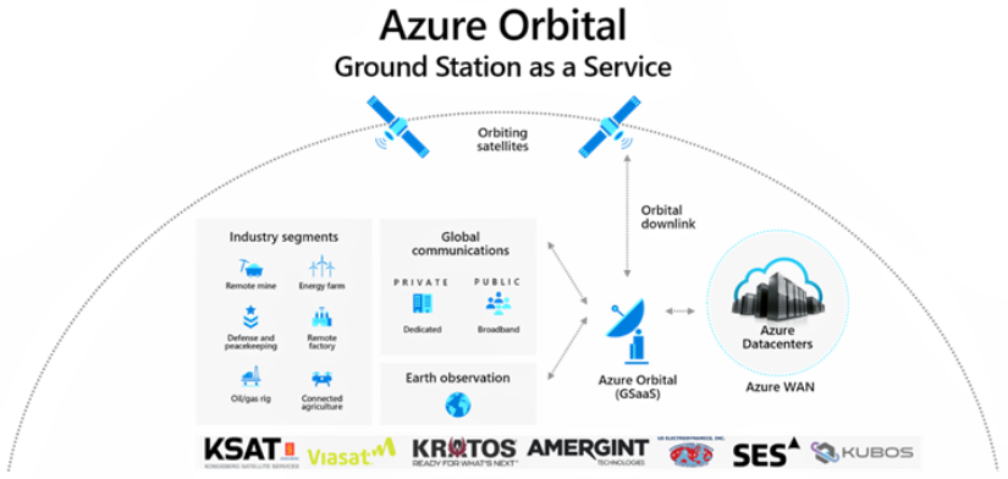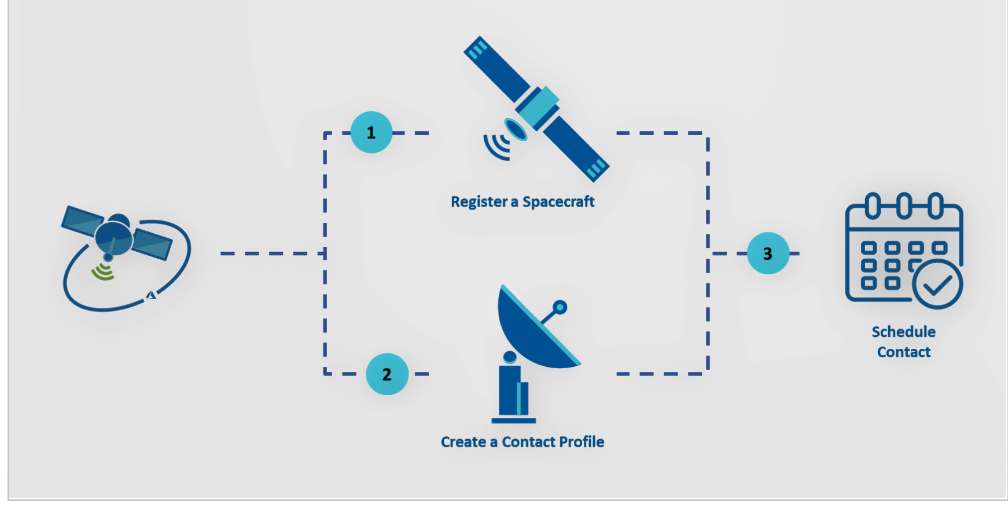Story by Yves Pitsch, Principal Program Manager, Azure Networking

Data collected from space to observe Earth is instrumental in helping address global challenges such as climate change and furthering of scientific discovery and innovation. The cloud is central to both modern communications scenarios for remote operations and the gathering, processing, and distributing the tremendous amounts of data from space.
Microsoft has announced the preview of Azure Orbital. The new ground station service enables satellite operators to communicate to and control their satellites, process data, and scale operations directly with Microsoft Azure. With Azure Orbital, the ground segment, including the ground stations, network, and procedures, becomes a digital platform now integrated into Azure and complemented by many partners.

Amergint, Kratos, KSAT, Kubos, Viasat, and US Electrodynamics INC. and have joined the ecosystem of Azure Orbital partners, each of them bringing their unique value and expertise for the benefits of our customers.
Microsoft is well-positioned to support customer needs in gathering, transporting, and processing of geospatial data. With the company’s intelligent cloud and edge strategy currently extending over 60 announced cloud regions, advanced analytics, and AI capabilities coupled with one of the fastest and most resilient networks in the world—security and innovation are at the core of everything we do.

Satellite images are used in many industries. Areas such as meteorology, oceanography, agriculture, geology, and defense and intelligence most often use satellites that are in a Non-Geostationary Orbit (NGSO), including Low-Earth Orbit (LEO) or Medium-Earth Orbit (MEO). As the satellites are orbiting, a substantial amount of ground stations are required to establish contact within a specific time window to downlink the data to Earth.
Azure Orbital enables satellite operators to schedule contacts with their spacecrafts and directly downlink data into their virtual network (VNet) in Azure. Azure Virtual Networks are isolated, highly secure, and governed by Microsoft’s more than 90 compliance certifications covering applications and datasets.
Azure Orbital on-ramps client data directly into Azure, where it can immediately get processed with market-leading data analytics, geospatial tools, machine learning, and Azure AI services.
Contact scheduling will be available for Microsoft owned and operated ground stations in X-, S-, and UHF-band frequencies via shared high gain antennas. Microsoft is also directly interconnecting the firm’s global network with partners’ ground station networks for easy scheduling with your preferred Teleport operators while maintaining the benefits of direct integration with Azure.

Whether a user selection is to use Microsoft or partner ground stations, the digitized Radio Frequency (RF) signal from the antenna to the cloud can be transmitted using the VITA Radio Transport (VRT) format (VITA-49) and then subsequently be demodulated using custom modems or cloud modems offered by the platform.
In-flight connectivity (IFC), maritime, connected cruise, mobility, and video broadcasting are examples of communication scenarios addressed by the space industry. Leveraging Azure Orbital, satellite operators can go beyond selling network capacity with the accelerated building of managed services. Azure Orbital offers interconnection of your existing ground stations and colocation of dedicated antennas close to our network PoPs or Datacenters. Orbital enables you to take full advantage of our global network and services infrastructure to build new product offerings and service chains with the edge, 5G, SD-WAN, and AI while continuously optimizing your operations and footprint.

The ground segment is a significant part of any satellite operator’s investments. An ecosystem of partners has joined our Managed Service Providers (MSP) program to enrich the platform by selecting services and technology integrations. Cloud modems optimized for Azure, Mission Control Operations are examples of third-party cloud-native services provisioned on-demand when your business needs it.
SES has selected Microsoft Azure to collocate the ground stations (including Telemetry, Tracking, and Command Systems) of their next-generation SES O3b mPOWER communication system. SES has designed a cloud-scale operational environment and will leverage Azure Orbital as a core platform to scale and build managed services and streamline order and service delivery management processes.
The integration is part of a multi-year agreement between the two companies that accelerates and expands SES’s use of Azure to significantly advance the digital transformation of the company’s services and operations as part of its cloud-first strategy.
As pioneers in Microsoft’s new cloud ecosystem in space, the two companies will make joint investments in Azure Orbital ground stations that SES will deploy and manage for the MEO and Earth Observation segments. The first MEO and Earth Observation gateways will be located in Phoenix, Arizona, United States and Quincy, Western Australia respectively
In anticipation of O3b mPOWER, SES’s next-generation MEO communications system, SES and Microsoft will seamlessly co-locate several telemetry, tracking and command (TT&C) systems and data ground stations with Microsoft’s Azure edge sites.
The integration of both SES and Azure networks will provide O3b mPOWER customers with “one-hop” access to their Azure cloud services. The option to route over Microsoft’s global network and inject value-added, cloud-based managed services such as enhanced security, SD-WAN, and other network functions into the service chain will mean that SES customers can enjoy improved network performance, speed-to-market, flexibility and scalability they need to capitalise on new revenue opportunities.
O3b mPOWER is SES’s next-generation MEO communications system. It is currently under construction and on track for launch in 2021. The high-throughput and low-latency satellites as well as automated and intelligence-powered ground infrastructure will deliver managed services of hundreds of Mbps up to multiple Gbps per second to customers.
This agreement builds on the work started last year between the two companies, which added SES as an Azure ExpressRoute partner and SES as the first satellite operator to implement Open Network Automation Platform (ONAP) using NFV technology on Azure.

“In the last 12-18 months, our focus has been to accelerate our customers’ cloud adoption plans. We are pleased to have found an ideal partner in Microsoft with its new Azure Orbital system. This agreement leverages both companies’ know-how – SES’s experience in satellite infrastructure and Microsoft’s cloud expertise – and are building blocks in developing new and innovative solutions for the future,” said JP Hemingway, CEO of SES Networks. “In addition to building and managing EOS gateways for Microsoft, we are also thrilled that we will be co-locating, deploying and operating our next-generation O3b mPOWER gateways alongside Microsoft’s data centres. This one-hop connectivity to the cloud from remote sites will enable our MEO customers to enhance their cloud application performance, optimize business operations with much flexibility and agility needed to expand new markets.”
“Our launch of Azure Orbital will enable our partners’ customers to on-ramp their data into Azure where it can immediately be processed with market-leading data analytics, geospatial tools and machine learning services, adding another layer of automation and intelligence in their networks,” said Jeff Cohen, Partner Program Manager, Azure Networking at Microsoft Corp. “In addition, SES’s O3b mPOWER communications system is proof of SES’s cloud-first strategy, focusing on industry standards and orchestration, and aligns with our connectivity vision for the future, and we are delighted to be kicking off this project.”
Azure Orbital is now in preview. For questions, feedback, and interest to participate in the preview, please contact [email protected].
